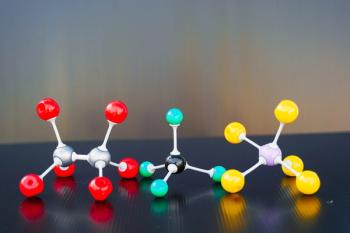
- January 2023
- Volume 19
- Issue 01
- Pages: 17–20
Playing with Selectivity for Optimal Chiral Separation
In this study, various ways of achieving resolution by playing with selectivity are presented.
Chiral separation is challenging and requires thorough method optimization. Selectivity plays a critical role in chiral separation. In this study, various ways of achieving resolution by playing with selectivity are presented. This resolution improvement can be realized from the stationary phase—the type of polysaccharide, nature of the chiral selector, position of the functional group in the chiral selector—the mobile phase composition, and from temperature. To optimize such challenging separations, it is important to explore all of these parameters through a chiral screening process across various chiral column chemistries.
Chirality is the potential of a molecule to occur in two asymmetric forms (enantiomers) that are non-superimposable mirror images of each other without changing the atomic composition, atom-atom connections, or bond orders. Chirality is a property of the whole molecule, but the cause of chirality is the chirality centre (asymmetric centre) within the molecule. It is important for an active chiral ingredient to be in one chiral form for a few reasons—the other chiral isomer can be inactive in the biological system or can have adverse effects. A good example of the adverse effects of a chiral isomer is described in the case of thalidomide (1–7), where pregnant women treated with this drug gave birth to children with birth defects due to the (S)‑enantiomer being teratogenic. To separate chiral isomers and quantify the amount of each isomer in a given mixture, a column that can recognize small spatial differences between one chiral isomer and the other is required. Many column phases have been developed to attempt to separate enantiomers and stereoisomers. This includes ligand exchange, protein-based, chiral crown ether‑based, cyclodextrin‑based, pirkle‑type, polysaccharide‑based, macrocyclic glycopeptide‑based, and cinchona alkaloid‑based phases. The most popular column currently used for this purpose is a polysaccharide-based chiral stationary phase (CSP). There are several advantages to using a polysaccharide-based CSP. Polysaccharide CSPs have a wide chiral recognition and selectivity, multiple chiral selectors, can be easily manipulated to reverse elution order, high pressure stability, high loading capacity, high efficiency, and—most importantly—scalability from analytical to preparative separation. Polysaccharide-based CSPs are also amenable to various separation modes such as reversed phase, normal phase, polar organic, and supercritical fluid. For the scope of this study, only chiral separation from polysaccharide stationary phases will be discussed.
Resolution Improvement
Resolution improvement in chromatography can be brought about by three different factors: efficiency term, selectivity term, and retention term. Out of these three, selectivity is the most influential term to bring drastic improvement in resolution. Selectivity for chiral separation can be realized from three main sources: the stationary phase, the mobile phase, and temperature. Within the stationary phase, selectivity differences arise from the type of polysaccharide and type of selector. Amylose or cellulose are the common polysaccharides used in chiral stationary phases and bring a difference in selectivity. The nature and the position of the functional group can have a huge impact on the selectivity and eventual resolution of chiral isomers. This will be discussed in detail in the following sections.
Selectivity from the Stationary Phase
Selectivity can come from the polysaccharide chosen for the stationary phase. Cellulose produces a tight, layered structure, whereas amylose has a more helical structure to help separate enantiomeric analytes (Figure 1). For example, tebuconazol was run on both a cellulose- and amylose-based chiral column with the same chiral selector. Figure 2 shows that enantiomers of tebuconazol can be separated depending on the polysaccharide. On the cellulose-based column, there was only a single peak that eluted. However, the helical structure of amylose allowed for the separation of the enantiomeric pair of tebuconazol and resulted in two peaks.
The chiral selector that is attached to the polysaccharide base can also affect the selectivity of a column. The chiral selector directs analytes towards the sugar moiety, thereby allowing for more specific selectivity depending on the analyte. As an example, fenarimol was analyzed using four cellulose stationary phases, each with a different chiral selector. Figure 3 shows how, depending on which chiral selector is used, the separation and retention times can be very different.
The enantiomers of diniconazole have very different separation or no separation at all depending on which stationary phase and chiral selector are used. Finally, the position of the side groups can also affect the selectivity of analytes. When analyzing myclobutanil, a simple position change of the methyl group allowed for the enantiomers to be separated completely (Figure 4).
Selectivity from the Mobile Phase
The content and composition of the mobile phase can also affect the selectivity of a chiral separation. The addition of an additive or adjusting the concentration of an additive can not only affect the separation of enantiomers but can also change the elution order. This can be seen with Fmoc-N-Isoleucine separation. As the concentration of formic acid (FA) increased in the mobile phase, the two enantiomers eluted together to form one peak, and then changed elution order, with the L- form eluting first with 0.5% FA in the mobile phase. This same shift was seen when FA was maintained and the ratio of the other two components of the mobile phase were changed. As the percentage composition of hexane increased, the selectivity change was clearly visible from the flip in elution order of enantiomers of Fmoc‑n-Isoleucine (Figure 5).
Selectivity can be enhanced by the addition of a mobile phase additive. For example, an analyte with three chiral centres (eight isomers) was analyzed. Under the current conditions with a two-component mobile phase, one of the critical pairs was not separated. However, with the addition of a third component to the mobile phase—the addition of 6% dichloromethane to the water and acetonitrile mixture—brought the critical pair resolution. The use of a chlorinated solvent such as chloroform or dichloromethane are allowed only on specialized phases (Figure 6).
Temperature-Based Selectivity
Temperature change can bring a drastic change in selectivity in chiral separation. Fmoc-N‑Isoleucine was further explored for the effect of temperature. The stationary phase and mobile phase were maintained, but the temperature was increased. At 5 °C the enantiomers were fully resolved, with the D-form eluting first. As the temperature was increased, the enantiomers were coeluted, and then finally a reversal of elution order was seen at 50 °C. The peak shape and peak efficiency were higher at higher temperatures (8).
Complementary Selectivities
Finally, the combination of the mobile phase and the chiral stationary phase can affect selectivity of enantiomers. The same mobile phase was used with different stationary phases to analyze Fmoc-N-Isoleucine, giving different peak shapes, separation, and elution order. It is advantageous to screen multiple phases for a higher chance of success and to obtain the desired order of elution.
Chiral Screening
When screening a specific chiral isomer by normal, reverse, and polar organic mode, the initial screening in normal phase with one specific polysaccharide column does not resolve the enantiomers; however, with reversed‑phase mode, the compounds were separated on the same column. Chiral separation is a three‑dimensional separation, unlike traditional reversed-phase separation. In reversed-phase chromatography using a C18 column, highly probable predictions can be made by looking at the structure of molecules, their hydrophobicity difference, and log P (octanol-water partition coefficient). However, with chiral separation, one should screen analytes through multiple phases and multiple modes to get the optimal resolution (9). Once the screening results are explored and the best separation is identified, further fine-tuning can then be done to optimize the method for the ideal separation (8).
Conclusion
Chiral separation is three-dimensional, and the resolution of a given separation can be improved by optimizing the selectivity. Selectivity in chiral separation can come from the mobile phase, the stationary phase, and the temperature of the analysis. To obtain high resolution and the right peak order that meets the goal of the analysis, it is important to consider optimizing all these aspects of selectivity before settling on the separation. Chiral screening is a prudent approach to explore the selectivity aspects of chiral separation.
References
- Burley, D. M.; Lenz, W. Thalidomide and Congenital Abnormalities. Lancet 1962, 279, 271–272. DOI: 10.1016/S0140-6736(62)91217-5
- Lenz, W. A Short History of Thalidomide Embryopathy. Teratology 1988, 38, 203–215. DOI: 10.1002/tera.1420380303
- Diggle, G. E. Thalidomide: 40 Years On. Int. J. Clin. Pract. 2001, 55, 627–631.
- Stephens, T. D. Proposed Mechanisms of Action in Thalidomide Embryopathy. Teratology 1988, 38, 229–239. DOI: 10.1002/tera.1420380307
- Bartlett, J. B.; Dredge, K.; Dalgleish, A. G. The Evolution of Thalidomide and its IMiD Derivatives as Anticancer Agents. Nat. Rev. Cancer 2004, 4, 314. DOI: 10.1038/nrc1323
- Wu, J. J.; Huang, D. B.; Pang, K. R.; Hsu, S.; Tyring, S. K. Thalidomide: Dermatological Indications, Mechanisms of Action and Side-Effects. Br. J. Dermatol. 2005, 153, 254–273. DOI: 10.1111/j.1365-2133.2005.06747.x
- Melchert, M.; List, A. The Thalidomide Saga. Int. J. Biochem. Cell Biol. 2007, 39, 1489–1499. DOI: 10.1016/j.biocel.2007.01.022
- Chankvetadze, B.; Farkas, T.; Peng, L.; et al. Enantiomer Elution Order Reversal of Fluorenylmethoxycarbonyl-Isoleucine in High-Performance Liquid Chromatography by Changing the Mobile Phase Temperature and Composition. J. Chromatogr. A 2011, 1218, 6554–6560. DOI: 10.1016/j.chroma.2011.06.068
- Phenomenex, Chiral HPLC/SFC Method Development Poster. https://www.phenomenex.com/ViewDocument?id=chiral+hplc_sfc+method+development+poster&fsr=1 (accessed 2022-12-19).
Ramkumar Dhandapani has been in the chromatography industry for over 20 years and has hands-on and troubleshooting experience in chromatography. He has earned a master’s degree and doctoral degree in analytical chemistry from Seton Hall University, New Jersey, USA, with specialization in microextractions, multidimensional gas chromatography, and tandem mass spec techniques. He has developed and validated several regulatory compliant methods in the pharmaceutical, food, and environmental industries. He joined Phenomenex in August 2014 and serves as Global Product Manager-Gas Chromatography at Phenomenex, USA.
Bryan Tackett earned a bachelor’s degree in biochemistry and genetics from Texas A&M University (Texas, USA) and a doctoral degree in translational biology and molecular medicine from Baylor College of Medicine (Texas, USA). He joined Phenomenex in September of 2020 and he serves as Technical Marketing Writer at Phenomenex, USA.
Articles in this issue
almost 3 years ago
Rising Stars of Separation Science: Martina Catanialmost 3 years ago
Agilent Achieves “Angel” Level Sponsorship of My Green Labalmost 3 years ago
Thermo Opens New Site in Chinaalmost 3 years ago
A Focus on Forensic Taphonomy and Chromatographyalmost 3 years ago
SCM-10 Event Previewalmost 3 years ago
Vol 19 No 1 The Column January 2023 North American PDFalmost 3 years ago
Vol 19 No 1 The Column January 2023 Europe & Asia PDFNewsletter
Join the global community of analytical scientists who trust LCGC for insights on the latest techniques, trends, and expert solutions in chromatography.




